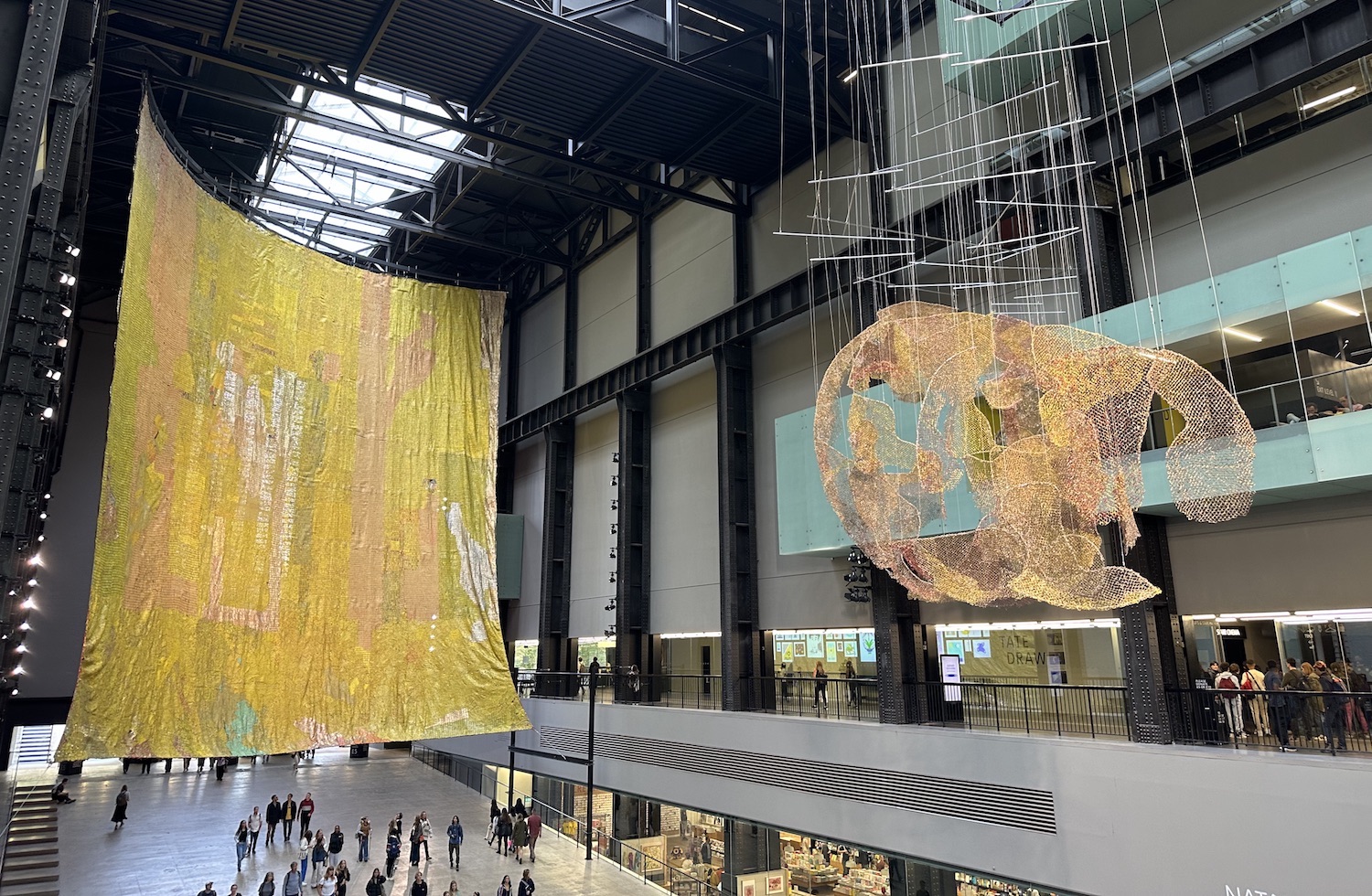In the cavernous expanse of Tate’s Turbine Hall, Ghanaian artist El Anatsui has orchestrated a visual spectacle transcending conventional installation art boundaries. His monumental creation, ‘Behind the Red Moon,’ unfurls a narrative as rich and intricate as the metal fragments it’s composed of. The exhibition, commissioned by Tate in collaboration with Hyundai Motors, is a powerful exploration of history, humanity, and global trade dynamics during the transatlantic slave era.
The first act, ‘The Red Moon,’ introduces viewers to a monumental sail, a majestic ship caught in the wind, heralding the commencement of a transformative journey across the vast expanse of the Atlantic Ocean. Anatsui crafts this awe-inspiring sail from liquor bottle tops, meticulously outlining the contours of a ‘blood moon,’ a haunting celestial spectacle witnessed during a lunar eclipse. The symbolism is as poignant as it is evocative, encapsulating the historical voyages and profound shifts that have shaped our collective human experience.

In the second act, ‘The World,’ Anatsui weaves a tapestry of human figures suspended in a state of perpetual unrest. Layers of thin bottle-top seals, intricately wired together, form an ethereal net-like material that conjures images of individuals in constant motion. From a specific vantage point, these fragmented shapes coalesce into a singular circular representation of Earth. The delicate dance of these figures encapsulates the essence of human restlessness, underscoring the relentless pursuit of unity amid the diversity of our global existence.
‘The Wall,’ the final act, stands as a monumental testament to the collision of cultures and identities that define our contemporary world. A towering black sheet of metal cloth stretches from floor to ceiling, adorned with shimmering silver and a mosaic of vibrant, multi-coloured pieces. At its base, pools of bottle tops rise like crashing waves and rocky peaks, a visual metaphor for the tumultuous confluence of cultures. Behind the obsidian surface, a delicate structure of silver emerges, a testament to the resilience of global identities in the face of inevitable change.
This symphony of lines and waves, oscillating between the depths of blackness and the vivacity of technicolour, encapsulates Anatsui’s profound meditation on hybrid identities and the global exchange of cultures. ‘Behind the Red Moon’ serves as an artistic catalyst, igniting contemplation about the complexities of our shared history and the evolving tapestry of our intertwined existence.
In this transcendent work, Anatsui invites us to engage with the collision of diverse narratives, fostering a dialogue about the shared human experience amidst a backdrop of cultural diversity. ‘Behind the Red Moon’ stands not just as an artwork but as a testament to the enduring power of art to provoke thought, inspire conversations, and bridge the chasms that often divide us.

Anatsui’s creation prompts viewers to delve into the material’s social narratives, offering glimpses into a contemporary industry rooted in colonial trade routes. The logos on the bottle tops tell profound stories, weaving together the past and present of Africa and Europe. The sculptures, suspended in mid-air, evoke a poetic exploration of elemental forces intertwined with human histories of power, oppression, dispersion, and survival.
Born in Anyako, Ghana, in 1944, El Anatsui is renowned for his experimental approach, incorporating diverse materials such as wood, ceramics, and found objects. His innovative use of liquor bottle tops, a medium he began exploring in the late 1990s, continues to evolve under his skilled hands. Anatsui, aided by a team of assistants, assembles these metallic hangings, embodying the concept of the ‘non-fixed form.’ With their ability to fold easily for travel, these sculptures assume new forms with each installation, reflecting the changing narratives of the objects he repurposes.
The Turbine Hall, a space that has witnessed the evolution of contemporary art since the inception of Tate Modern in 2000, now bears witness to Anatsui’s magnum opus. ‘Behind the Red Moon’ joins a prestigious lineage of transformative artworks, leaving an indelible mark on the audience.
The scale of these stunning sculptures must be witnessed in the flesh to feel the impact of their sublime beauty. I asked the artist if the pieces were site-specific, and he said given the right place to display, they could be rolled up and travel to another exhibition space. Look out for an El Anatsui foundation to be opened in the future, likely near his studio in Ghana.
Anatsui has exhibited around the world, including recent solo projects at La Conciergerie, Paris (2021); Haus der Kunst, Munich (2019); Mathaf: Arab Museum of Modern Art, Doha (2019); and Kunstmuseum Bern (2020). He received the Charles Wollaston Award at the Royal Academy of Arts, London, 2013 and was awarded the Golden Lion for Lifetime Achievement at the 56th Venice Biennale in 2015. In 2019, a significant installation was exhibited at the Zeitz Museum of Contemporary Art Africa (Zeitz MOCAA), Cape Town, and his work was included in the inaugural Ghana Pavilion at the Venice Biennale. Anatsui’s work is held in permanent collections worldwide, including The Metropolitan Museum of Art, NY; the National Museum of African Art, Smithsonian Institution, Washington DC; The British Museum, London; and the Centre Pompidou, Paris. From 1996 to 2011, he also worked as Professor of Sculpture and Departmental Head at the University of Nigeria, Nsukka.
Words/Top Photo P C Robinson © Artlyst 2023
***** Five Star
For more information, visit Tate Modern.

